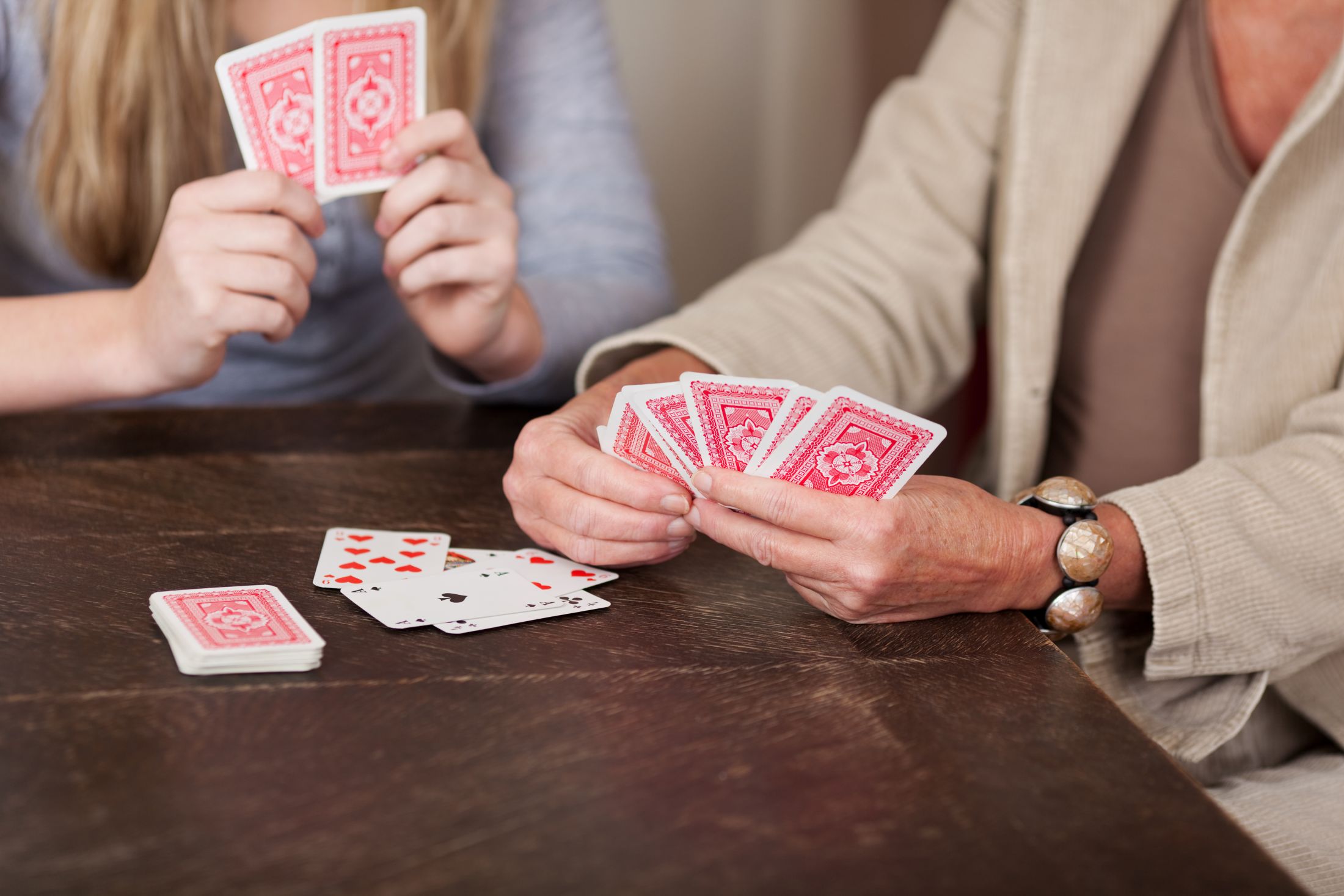Games to get the Party Started!
Whip up some tasty appetizers, grab some friends and have a blast!
Let your party diva crown shine by adding some fun games to your next gathering. It’s a great ice breaker for new friends and a fun way to bring close friends and family together at gatherings.
Here are some of our favorite party games to try at your gathering. Be sure to take pictures and use the hashtag #halladaysathome to be entered to win free stuff!
THE LAUGHING GAME
- Get everyone seated round a table or in a circle.
- Players take it in turns to say “Ha”, “Ho” or “Hee”. Anyone who starts laughing is knocked out of the game.
- Keep going until everyone’s out.
- The person who keeps a straight face the longest wins.
SING SONG PONG
- Decide early on what type of songs to use. Decide who goes first, with that person singing a line of a song (preferably the chorus, always easier).
- The rest of the group then think of another song featuring any of the words currently being sung.
For example, “Whoa-oh, we’re living on a prayer” (Bon Jovi)…
The next song sung could be “When you call my name, it’s like a little PRAYER” (Madonna)…
With the song to follow that “Even on my weakest days, I get a LITTLE bit stronger” (Sara Evans)
- Players get a point each, for each correct connecting word. Round out these adult party game ideas with a singalong.

WHO IS IT?
- Stand in a circle. Blindfold a guest and have them stand in the middle.
- On ‘Go!’ they must reach out to the circle, and asks “who is it?”
- The first person they nab must answer, only in a weird voice.
- If the blindfolded one guesses who this person is, the players swap for a new round.
- But if they guess incorrectly? The game continues until someone is caught.
PASS THE ORANGE
The most well-known of adult party game ideas here. You’ll need two oranges and plenty of space.
- Break into two lines, each with varying head heights. The first players are given an orange to hold between their chin and neck.
- On ‘Go!’ the orange is passed down each respective line, from the chin of one person to the chin of their teammate.
- No hands are allowed to touch the orange during its passage. Unless it drops. In this case, the orange is passed back to the first player and their whole line starts again.
- To win, the last player with the orange must transfer it back to the first, via their chin.
- You also can play with 4 smaller teams. Run this game as before, with the fastest team winning.
- You can also play as a circle.
- Also, try playing with odd-shaped vegetables – like turnips and avocados.
BALLOON VOLLEY BALL
Unlike regular volleyball, using a balloon means you can play indoors without risk to furniture (or people). You can also play by sitting on the floor.
- String up a net (with rope or a long bedsheet), and divide into two equal teams.
- Start the game, by instructing the first team with the balloon to hit it across the net to the next team. The other team then hits it back.
- If a team fails to hit the balloon, or the balloon hits the floor – the opposite team scores a point.
- Set a time limit for each round.
- The team with the highest score in a given series of rounds wins.
- For extra mess, fill the balloon with shaving cream…but play outside.
DANCING CHAIN
- Stand everyone in a circle, and nominate someone to start the dance chain. They do this by making a simple dance move. Such as? Waving their hands in the air. Or kick out a leg. Or jumping once. Keep the move simple, as everyone else will need to copy it.
- The player to their left then leads the circle, by repeating the move.
- Once the entire circle has done it, this new player repeats the move, before adding their own.
- The player to their left then leads the circle with the new move, and so on.
- Keep the whole thing going, until an entire dance routine has been created. The game ends with the whole circle performing the routine together.
ICE CUBES
- Split everyone into two even teams.
- On ‘Go’, the first player of each picks up an ice cube and tries to melt it as quickly as they can. They can rub it between their hands or their clothes – but what they can’t do is put it in their mouths, stomp on it or use any equipment on it (e.g. a lighter).
- No one is allowed keep a cube for more than a few seconds, so make sure the cubes are being passed between players.
- First team to melt the cube (or tray of cubes) wins.
CHARADES RELAY
- Before playing, write down a list of 15-20 everyday life scenarios. E.g. Marriage proposal, tread in dog doo, miss the bus.
- Break everyone equally into Teams A and B. Everyone in Team A leaves the room, bar one person. Team B will be the audience.
- Quickly show one of your life scenarios to the member of Team A. After 10 seconds, a 2nd member of their team returns.
- Teammate 1 now acts out a clue to help Teammate 2 guess the scenario – using only mime. After 10 seconds have passed, a 3rd member of Team A returns. Teammate 2 now acts out what they think the scenario is. And so on.
- The last person of Team A then makes the final guess. Once done, Team B takes their turn.
REACT & ACT!
Setup
React and Act involves some preparation; however, this is part of the fun! Pass out sheets of paper and pens to the players. Have each person write an event. Tell them to be creative! Examples of events can include:
- Being surprised by a large, aggressive bear in the woods.
- You just won the lottery.
- You have just been proposed for marriage with an engagement ring.
- You just got fired by an incompetent boss.
- Making the game winning pass to win the Superbowl.
- You just fell in love.
- Once everyone writes an event, fold the paper once and place it into the bag. Divide the group into two teams (or select five volunteers if it is a very large group).
How to Play
- Ask five people on each team to randomly select an event from the bag. Instruct them to react to this event, without explicitly giving away what the event is. Choose a time limit (usually 30 seconds to a minute works well) and when you say “Go!” have all five people to simultaneously react to their event using exaggerated gestures, facial expressions, and their voice.
- For example, the person who has just won the lottery could raise his or her arms and scream excitedly, jumping up and down. The person who has just confronted a bear might make a terrified look, shake in fear, and call for help. And so on. Each of the five actors can interact with each other, but they must stay “in character” and continue reacting and acting based upon what their sheet said.
- After time expires, the other members of the team try to guess what happened for each person. If you wish to keep score, each team gets a point for each correct guess. This game is a great way to break the ice, while watching people act out silly (and usually hilarious) things.
Variations
- There are many variations to React and Act that changes the way the game is played. Try experimenting with these and see whether you like them.
- No talking allowed, but noises are okay. This increases the difficulty of the game by a lot, but it can be more hilarious.
- Narrator explains the event before each person acts.
GIANTS, WIZARDS, ELVES
Giants, Wizards, and Elves is an icebreaker that is similar to Rock, Paper, Scissors — except more hilarious! It’s also a versatile game — it works in groups of all sizes, including large groups of 50 or above.
This icebreaker game involves two teams and requires no special materials to play. It works both indoors Setup
This game involves two teams who will act as one of 3 characters: giants, wizards, and elves. When a player acts out a character, he or she does the specific hand motions and also makes the noise associated with the character.
Giants. Stand on your tippy toes, raise your arms like a giant, and make a menacing growling noise: “Rarrr!"
Wizards. Crouch slightly, as wizards are a bit shorter. Wave your fingers as though you’re casting a magical spell, and make a magical noise: “Shaazaam!"
Elves. Crouch down very low, cup your hands around your ears, and make a high pitched elf noise: “Eeeee!"
- Make sure everyone knows the motions and sounds. Feel free to practice until everyone knows how to become each character. Split everyone into two teams and divide them into separate sides of the room. For each round, both teams huddle and choose to become a giant, wizard, or elf. When ready, both teams then line up and stand facing each other, about five or six feet apart. At the start of each round, the leader says “Three, two, one, go!!"
- At this point, each team acts out the character they chose (giant, wizard, or elf). As soon as they do this, the winner tries to grab the loser — as many people over to their side as they can. The loser tries to retreat back to their own side to be safe for that round. If captured, a person now belongs to the other team. The following determines who beats who:
- Giants beat elves, because giants are able to “squash" elves. Elves beat wizards because they outsmart them. Elves chew at their legs. Wizards beat giants because they are able to zap them with a magic spell. If both teams show the same character, no one wins. Rounds keep repeating until one team wins (the other team is completely captured).
TWO TRUTHS AND A LIE
Recommended group size is: small, medium, or large. Works best with 6-10 people. Any indoor setting will work. No special materials are needed, although pencil and paper is optional. For all ages.
- Ask all players to arrange themselves in a circle.
- Instruct each player to think of three statements about themselves. Two must be true statements, and one must be false.
- For each person, he or she shares the three statements (in any order) to the group. The goal of the game is to determine which statement is false. The group votes on which one they feel is a lie, and at the end of each round, the person reveals which one was the lie.
Variations
“Two Truths and a Dream Wish.” – An interesting variation of Two Truths and a Lie is “Two Truths and a Dream Wish.” Instead of telling a lie, a person says a wish. That is, something that is not true — yet something that the person wishes to be true. For example, someone that has never been to Europe might say: “I often travel to Europe for vacation." This interesting spin on the icebreaker can often lead to unexpected, fascinating results, as people often share touching wishes about themselves.

SPOONS
Needed
- Cards - Any kind that have 4 of the same number
- Spoons - enough for everyone at the party, minus one
- Paper and Pencil - For keeping score
Setup
Take four of a kind out for as many people as you have (if you have 4 people playing, take out a set of ones, twos, threes and fours), there should be 4X the number of people you have.
Shuffle the cards. Pass them out until they are gone. Everyone should have 4 cards.
Put out the spoons. Enough for everyone, minus one.
How to Play
- The dealer for this round is in charge. The object is to get 4 of the same number.
- Everyone will take a card that they don't want and when the dealer says "Pass" everyone passes their unwanted card to the person on their left. They should all have 4 cards again. Then they pick another card they don't want.
- Play continues, everyone passing their unwanted cards when the dealer indicates, until somebody gets four of a kind. When someone does, they grab a spoon.
- Once someone grabs a spoon then everyone else can as well. The person that doesn't get a spoon gets an "S" on the score sheet then the cards are turned in to the next dealer.
Scoring
The first person that doesn't get a spoon gets an "S". The next time that person doesn't get a spoon they get an "O" and it continues on, until that person spells "Spoon" at which time they are out of the game.
The last person who hasn't spelled "SPOON" wins.
KING ELEPHANT
King Elephant (also known as Animal Kingdom Game) is well suited as a good party game or an icebreaker for meetings. It involves a little bit of silliness and is a lot of fun. The goal of the game is to become the King Elephant, the head of the circle.
This active game works best if you have between 8 and 15 people. It is a good indoor game, and although it does require some movements (mainly making animal gestures), there is no running involved. No special props are required – it’s pretty simple to play! The recommended age is 10 and up.
Setup
Not much setup is required. Instruct all players to have a seat and arrange everyone in a circle, facing each other. Each seat in the circle will be a different animal, arranged in order from the top of the food chain (the King Elephant) down to the bottom of the food chain (a slimy worm). Designate one person to be the King Elephant and then assign the other animals in order. If you wish, you can let players choose their own animal and invent their own gesture for the animal. Otherwise, typical motions for the animals are:
- King Elephant – hold one arm out, extended away from your nose, while the other arm wraps around and holds your nose.
- Bird – join both of your thumbs together and flap your hands like a bird flying
- Chicken – place your hands under armpits and flap your arms
- Alligator – extend your arms out in front of you, with one hand facing up, and the other down, and clamp them both together like an alligator’s jaws
- Bear – hold your two hands out like giant bear claws
- Lion – connect your hands above your head like a circle, make a growling face like a lion’s roar
- Snake – make a slithering snake movement with one of your arms
- Fish – clasp both your hands together and imitate a fish swimming upstream
- Monkey – puff cheeks, while pulling your ears out
- Worm – wiggle one bent finger
Instructions
- King Elephant is a rhythm game in that you must successfully stay on beat. Depending on the chair you are currently seated in, each person adopts an animal gesture (as described above, or you may create a new one). The task is to correctly do your animal signal when called upon, and then to make another animal’s signal to try to get that person to make a mistake.
- The rhythm to maintain is set by the person who is King Elephant. He or she can alter the speed as desired. Everyone follows the rhythm of a 1-2-3-4 pattern, where 1 is a pat on the knee, 2 is a clap, 3 and 4 are left and right thumbs (or the signals). The person does his or her own signal (animal gesture and noise) first, followed by another animal’s signal.
For example, a round could look like this: King Elephant starts rhythm: knee pat, clap, elephant signal (his or her own signal),
King Elephant signals a different player: knee pat, clap, bear signal (or anyone else’s signal),
Bear continues: knee pat, clap, bear signal (his or her own signal),
Bear signals another player: knee pat, clap, fish signal,
Fish continues: knee pat, clap, fish signal (his or her own signal)..and so on.
- When people fail to keep the rhythm or make a mistake on their signal (e.g. do a signal when they aren’t supposed to) then they become the new worm and everyone else moves up by sliding up a seat. Those who change seats take on the role of a new animal.
- The goal is to try to be the King Elephant by knocking out anyone in front of you.
Great fun! Be sure to get everyone to make funny animal sound effects when they do their signal too.
STRANGE DISEASE DIAGNOSIS GAME
Uh oh, the patient is acting really strange! What illness does he or she have? The Strange Disease Diagnosis Game (which also goes by several other names, including the Mysterious Illness Game, Doctor Game, Psychiatrist Game, or Diagnosis Game) is a fun party game that involves some acting and guessing. It involves some improvisation and silliness. It works in different sized groups, although smaller groups of about 5-10 people is probably best.
Setup
This is a relatively easy drama game which may be improvised or may involve some rehearsal or preparation if you so wish. The easiest way to play this game is to have one person playing the doctor and the other people play the patients. The doctor is asked to leave the room and the patients decide what disease, illness or syndrome they all have. For example, the patients comes up with a strange syndrome or disease that they all think they are chickens, that they are Sarah Palin, that they are secret agents, or so on.
Instructions
- The doctor must figure out what is wrong. He or she may ask any player a question, but everyone keeps track of the number of questions. After each question, the doctor can make a guess (diagnosis) of what he or she thinks is wrong.
- Of course the patient cannot just say what their condition is; they need to give clues in their performance. A person who thinks they are a chicken will suddenly cluck without reason. If they think they’re Sarah Palin they might try to get them to vote for them. If they think they are being spied on they may look under the table, and so on. A doctor needs to ask questions, but need to do so in the role of a doctor.
- When the doctor has correctly guessed the name of the condition (or close enough) or alternatively has given up and the patient has revealed it the patient and the doctor should change places and it’s the other person’s turn to guess.
- If you want to play it in teams of two, one team could be doctor and patient while the other team could try to guess the syndrome. Then the teams switch places.
STICKER STALKER
A great game to keep everyone on their toes.
- Everyone at the party has 10 stickers and must get rid of them by sticking them to the other guests without them noticing.
- If someone catches you, they can stick one of his/her stickers on you.
- First one to empty their sticker sheet wins!
HAMBURGER
Needed: Post-It notes, Sellotape and a pen to play.
- A different ingredient for the burger is written on each note and then taped to the back of each player.
- They now rearrange themselves, in the correct order a burger is made.
- You can add a competitive element to the game, by having two teams do this as a race
THE CONTINUING NOVEL
- Players sit in a circle. The first person is then given 30 seconds to write a story six lines long.
- When time’s up, the story is folded so the last line shows.
- The story is passed to the next person to continue.
- The last player reads out the whole thing out
Add a fun theme, too. E.g. Got kicked out of a bar for having no pants on.



